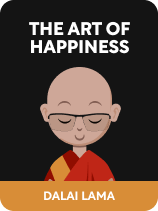

This article is an excerpt from the Shortform book guide to "The Art of Happiness" by Dalai Lama. Shortform has the world's best summaries and analyses of books you should be reading.
Like this article? Sign up for a free trial here .
Why do they say that “human is a social animal”? And if so, why do so many of us suffer from loneliness?
Humans are social animals—we need interactions with other humans to make us happy. Science confirms this adage: Loneliness has been proven to deteriorate health and even reduce lifespan.
Here’s why connecting with others is vital to mental health.
We Need Other Humans to Be Happy
The Dalai Lama believes that all humans are dependent on others for their wellbeing and happiness. To prove this, he points to the fact that others provide the material goods and services we rely on for survival. Many people built your home, made the food you eat, and contributed to your education.
Even in today’s tech-driven society, in which we could survive for months without seeing another human, survival remains contingent upon the efforts of many people. Even an action as impersonal as ordering off Amazon requires the input of many: those who created the algorithms that keep warehouses stocked, those who keep your information safe, those who fulfill your order and deliver it to your home, and so on.
Form Many Intimate Relationships
Connecting with others is important, but not all connections are created equal: The type of connection you forge matters: According to the Dalai Lama, establish intimacy between yourself and many different people. Humans have defined intimacy differently across cultures and time, and there’s no overarching definition. In this book, Cutler and the Dalai Lama propose that an intimate relationship is one in which you’re open with the other person and experience a connection.
(Shortform note: It’s true that the level of intimacy you establish with others matters to your happiness. Someone with many loose connections can feel lonelier than someone with only a few close friends. Similarly, relationships marked by conflict and a lack of trust can fail to provide a sense of connection. However, individuals also have different tolerances for alone time and therefore, someone with a few close friends might still long for more connection because they don’t enjoy being alone. Optimizing your social life is a balancing act, and you must listen to your unique needs.)
The Dalai Lama adds that the fact that intimacy is defined in so many different ways means you can—and should—establish many types of intimate relationships with many people. For instance, forge an intimate relationship with a school friend that’s based on an academic experience and an intimate relationship with a fellow parent that’s based on the experience of parenthood.
(Shortform note: The Dalai Lama recommends forming intimate relationships with many people. You can view this alternatively as widening your social network, which makes you not only happier but also more connected. Widening your network might entail transforming what would otherwise be a meaningless interaction into an opportunity to connect. When you make this effort, the interaction can leave you feeling as emotionally satisfied as a chat with a confidant.)
From a scientific perspective, Cutler writes that intimacy promotes both physical and psychological health. It also prevents the anxiety that separation and alienation foster.
(Shortform note: Cutler argues for the benefits of intimacy, but it can be intimidating to establish intimacy because this demands time. If you feel overwhelmed by the prospect of being emotionally intimate, consider that intimacy doesn’t have to mean being someone’s die-hard best friend. Instead, just focus on establishing a connection and being yourself.)
The Dalai Lama clarifies that there’s no magic formula for establishing many intimate relationships. However, two necessary ingredients go into building them: compassion and a solid foundation. Let’s look at each individually.
Form Many Intimate Relationships by Being Compassionate
According to the Dalai Lama, unconditional compassion is critical to a good relationship. Unconditional compassion lets you approach others with openness and caring, thereby laying the groundwork for strong relationships. Even if the response to your compassionate outreach is negative, you won’t have closed off the possibility of a positive interaction yourself.
(Shortorm note: The Dalai Lama advises you to approach everyone with compassion, so you always create at least the possibility for connection. But sometimes, despite being compassionate, you simply can’t connect with someone. In such cases, being curious about the other person can lead to them opening up about themselves.)
The Dalai Lama believes that compassion is a mindset that wishes others well, eschews negative thoughts toward others, and is rooted in a feeling of responsibility toward others. Compassion also encompasses the wish for oneself to be well.
(Shortform note: Others have defined compassion in different terms than the Dalai Lama: Some believe compassion is an understanding of someone’s suffering and a related desire to help alleviate it. Compassion, therefore, could be empathy (the ability to feel someone’s pain—we’ll cover this in the next section) combined with action.)
The Dalai Lama doesn’t promise that cultivating compassion will always allow everyone to connect. Some people grew up in difficult circumstances that make compassion hard, and in general, you usually can’t always be totally compassionate. However, the Dalai Lama feels that as long as you make an effort, you can feel good about having tried.
(Shortform note: As the Dalai Lama proposes, it’s impossible to be fully compassionate in every possible situation, in large part due to our upbringing. Anger in parents, for instance, can lead to increased aggression and reduced empathy in their children. Unless counteracted, this carries on into adulthood and can make it difficult for adults to access compassion.)
Foster Compassion by Developing Empathy
The best way to foster compassion is to develop empathy, says the Dalai Lama: the capacity to understand another’s pain and suffering. To do this, put yourself in the shoes of that person. Think about what their pain is like. If you struggle with this, imagine the suffering of someone or something you love dearly, like a family member. Once you’ve awakened your empathy, apply it to all sentient beings.
(Shortform note: The Dalai Lama recommends imagining someone else’s suffering to awaken your empathy. But there are other, more actionable ways to develop your empathy: Strike up conversations with new and different people to learn about their lives. Or visit new communities or institutions in your neighborhood to gain a fresh perspective. Also consider joining a new group through which you work on a shared goal with others: for instance, volunteering at a farmer’s market.)
It may take creativity to imagine what someone else’s suffering is like, warns the Dalai Lama. But if you take the time to do this, the empathy you build comes in handy in most facets of life.
(Shortform note: As the Dalai Lama suggests, empathy is useful in many areas of life. Empathy helps you be a better manager at work and a more supportive friend and family member.)
Foster Compassion by Considering Commonalities and Background
Also foster compassion by searching for commonalities between yourself and others and by taking into account their backgrounds, advises the Dalai Lama. First, approach others with the conviction that you have a lot in common. Let’s say you’re going on a first date with someone who works in a different field at a different pay grade. Rather than feeling that you can’t possibly have anything in common, approach them with the conviction that you actually have a lot in common: You’re both humans with the need for affection and love. This lets you approach the date with compassion rather than enmity.
(Shortform note: In this discussion of cultivating compassion by finding common ground, the Buddhist concept of emptiness can be helpful. As discussed in a previous comment, emptiness is the idea that no one (and nothing) has a fixed identity. Everything is constantly changing and made up of smaller pieces and caused by other conditions. You could therefore view a human not as an unchangeable, self-contained flesh-and-blood being, but as an entity shaped by upbringing and circumstances and in perpetual transition. Viewing other humans in this fluid way can help you overcome barriers to connection.)
Second, as far as possible, take into account someone’s background when interacting with them, advises the Dalai Lama. If you know someone’s struggling with a particular issue—illness, for instance—it might account for their closed-off behavior. Bring extra compassion to the interaction, and you might break through the barrier of antagonism.
(Shortform note: While bringing extra compassion to people in difficult situations is usually a good thing, it’s possible to prioritize others’ feelings over your own in a way that’s detrimental to you. If you feel, for instance, that you think more about the needs and feelings of another than about your own, you may need to direct more of your compassion toward yourself.)
Foster Compassion by Meditating on It
The Dalai Lama’s final recommendation for fostering compassion is through meditation. To do this, follow these steps:
Recognize that your aims in life are to be happy and to avoid suffering. Recognize that all beings everywhere also have the aim to be happy and avoid suffering.
Now, visualize someone who’s suffering. Think about their suffering from all angles systematically. Recognize that this person has all the same needs as you do and that pain, suffering, happiness, and comfort affect them in the same ways as you.
From that recognition, allow any natural feelings of compassion for this person to arise. Try to determine that you don’t want this person to suffer. Try to decide that you will try to help the person be free from suffering. Focus all your attention on that single desire and try to generate further feelings of compassion.
| Types of Buddhist Meditations This type of meditation is perhaps best described as a Metta meditation (more on this below). There are several different types of meditations across the two main divisions of Buddhism: Theravada and Mahayana. (The most basic distinction between these divisions is that Theravada Buddhists seek to achieve enlightenment so they can be free of Samsara, the cycle of rebirth, and achieve Nirvana. Mahayana Buddhists, meanwhile, try to stay in the cycle of rebirth, so they can help others achieve enlightenment.) Here are three types of traditional Buddhist meditation: Shamatha: This meditation helps you become mentally calm. It might entail focusing on your breath and letting your thoughts drift by. Vipassana: This usually follows a Shamatha meditation and is designed to give you greater insights into your mind. Metta: This meditation involves cultivating and sending loving thoughts and feelings to others. |

———End of Preview———
Like what you just read? Read the rest of the world's best book summary and analysis of Dalai Lama's "The Art of Happiness" at Shortform .
Here's what you'll find in our full The Art of Happiness summary :
- The Dalai Lama's Buddhist path toward happiness
- The use of scientific evidence to support the Dalai Lama's beliefs
- Concrete actions you can take to improve your outlook on life, relationships, and resilience






